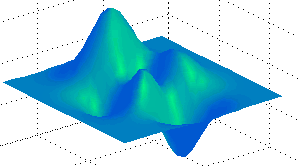
The
Ph.D. thesis:" Contribution to the second part of the 18th Hilbert problem " 1986 subject classification number
according to the AMS 51,52 .
Comments and Interpretation:
The subject of the PhD thesis is in Discrete and Computational Mathematics.
The next papers were written during 1991-1992. I re-derive the main results of the characterization of polytopes that are space-fillers in Euclidean spaces, but this time starting with all the spectrum of spaces from topological , to differential , affine differential ,Riemannian, and finally in spaces of constant curvature. Some of the results were presented at Smith College in Northampton USA and Oxford University UK.
As the author sees it today ,the Differential Calculus may be elaborated to have in addition the information of the resolution on which it is referring. This would lead to Resolution-Specific Differential Calculus. The present differential calculus is resolution- free. In resolution-specific differential calculus, the reference on more than one resolution (Multi-Resolution-Specific Differential Calculus) leads naturally to pre-emptive or non-Archimedean ordering, and to practical interpretations of the transfinite numbers (see papers on "Infinite"). This requires maybe a principle like: "The ontology of the infinite is created by relations in the parallel computations on the finite" or " The ontology of infinite is the interplay of the finite of meta-mathematics or formal Logic with the finite of objective mathematical entities"
There is of course an approach quite finitary based on two resolution , the significant or coarse and the fine-detailed. Much like the choice in computers of the representation of real numbers with double or single precision. In this approach for the definition of the derivative dy/dx , it is not required a limit at all , but the dx are finite defined in a fine resolution ,while the quotient is rounded in the coarse resolution. The equalities of the differential relations are rounding relations rather than equality of numbers .E.g. the derivative of x^2 is [(x+dx)^2-x^2]/dx which is equal to 2x+dx, and for the coarse resolution (e.g. single representation) it is rounded to 2x! This is not a clumsy , substitution of the concepts of limit at all. On the contrary it is a much more comprehensive approach, and closer to what Newton and Leibniz had in their mind, without the later interventions of Weirstrasse. With this finitary ,without limits approach , differentiability depends on the size of the two resolutions of interest and many traditionally non-differentiable functions (with the definition with the limit) are differentiable. Actually, for many classically discontinuous function, there are two resolutions on which they are differentiable! Such an approach permits easy finitary without limits definitions of Dirac's deltas, without any functional analysis at all. Such entities maybe defined in at least resolutions, or number systems, and in the coarser some of their properties are null or as if non-existing. Luckily there is a precise interpretation and definition of the double resolution technique, with which all the known traditional formulas of differential calculus (with the definition with the limit) became valid with the double resolution interpretation. This saves the work done hitherto. Still the concepts are different and may lead to different conclusions in the general case. I hope that in future papers I shall clarify the concepts ,techniques and results.
Examples where it is used the reference in two different (coarse) resolutions in the same system , in which different and even contradictory equations hold, is the well known situation in fluid dynamics of water. The water is considered incompressible fluid in some macroscopic scale-resolution and at the same time when studying the propagation of sound in water in a smaller scale-resolution we certainly describe compression waves. There are other situations in physics of fluids that may reveal new laws if we accept more than one resolution in the same fluid with different differential equations in each of them and still related with inter-resolutions correlations.
A phenomenon may have system of equations on high resolutions, and some of its equations may turn in to null as the resolution gets coarser. This is a concept of layered or hierarchical, in respect to resolution, system of equations or laws of social or physical phenomenon. The hierarchy, depends on the hierarchy of resolutions or accepted quantitative accuracy or significance level.

2) Universally uniformisable space-forms in differential, affine differential and categories of manifolds of constant curvature.(1991)
3) Partial action and space-forms 1.(1991)
4) Partial action and space-forms 2.(1991)
5) Tilings , polytopes and space-forms.(1992)
6) On the Penrose problem(1992)
7) Contribution to the second part of the Hilbert problem 18: Characteristic local rules for arbitrary tilings (1992)
8) Applications of the characteristic local rules of tilings in Riemann manifolds.(1992)
9) Applications of the characteristic local rules of tilings in metric, and measure (partial ) Dynamical systems .(1992)
